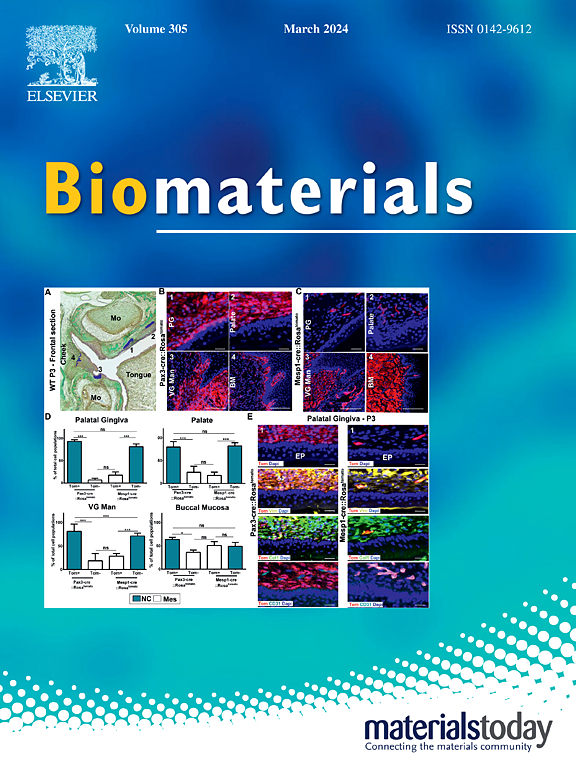具有微环境调节和周围神经病变修复协同作用的聚硫辛酸弹性体胶粘剂促进感染性糖尿病创面愈合
IF 12.8
1区 医学
Q1 ENGINEERING, BIOMEDICAL
引用次数: 0
摘要
糖尿病伤口由于其恶劣的炎症微环境和高血糖引起的周围神经病变,其愈合困难和复发率高。然而,目前的研究往往忽视了糖尿病周围神经病变对伤口愈合的影响。本研究将天然活性分子硫辛酸(LA)与临床应用的降糖药物二甲双胍(Met)结合,结合重塑创面微环境和恢复周围神经功能的特点,同时通过胍基与羧基之间形成强盐桥氢键来稳定聚乳酸,开发出一种黏性弹性创面敷料。弹性敷料表面富含黏附羧基,可与组织形成多个氢键或静电相互作用,对糖尿病创面起到有效的密封保护作用,从而抵抗有害细菌的侵袭。LA和Met在创面部位持续靶向释放,可有效降低局部氧化应激,增加胶原沉积和血管生成,显著上调神经内分泌化学物质和神经纤维标志物,促进病灶周围周围神经的恢复。在大鼠糖尿病感染模型中,polyLA-Met贴片的创面愈合效果明显优于3M市售敷料。本文章由计算机程序翻译,如有差异,请以英文原文为准。
A poly(lipoic acid)-based elastomer adhesive with synergistic activity of microenvironment regulation and peripheral neuropathy repair facilitates infectious diabetic wound healing
Diabetic wounds are notorious for their difficulty in healing and high recurrence rate, due to their harsh inflammatory microenvironment and the peripheral neuropathy caused by a hyperglycemic condition. However, current research often overlooks the impact of diabetic peripheral neuropathy on hindering wound healing. Here, we develop an adhesive elastomeric wound dressing by combining the natural active molecule lipoic acid (LA) with the clinically applied hypoglycemic drug metformin (Met), integrating the characteristics of remodeling the wound microenvironment and restoring peripheral nerve function, while stabilizing polyLA through the formation of strong salt bridge hydrogen bonds between guanidyl and carboxyl. The surface of the elastomeric dressing rich in adhesive carboxyl groups can achieve effective sealing protection for diabetic wounds by forming multiple hydrogen bonds or electrostatic interactions with the tissues, thereby resisting harmful bacterial invasion. The sustained targeted release of LA and Met at the wound site can effectively reduce local oxidative stress, increase collagen deposition and angiogenesis, and significantly upregulate neuroendocrine chemicals and nerve fiber markers, promoting the recovery of peripheral nerves around the lesion. In the diabetic infection model in rats, the polyLA-Met patch shows a significantly superior wound healing effect compared to the commercial 3M dressing.
求助全文
通过发布文献求助,成功后即可免费获取论文全文。
去求助
来源期刊

Biomaterials
工程技术-材料科学:生物材料
CiteScore
26.00
自引率
2.90%
发文量
565
审稿时长
46 days
期刊介绍:
Biomaterials is an international journal covering the science and clinical application of biomaterials. A biomaterial is now defined as a substance that has been engineered to take a form which, alone or as part of a complex system, is used to direct, by control of interactions with components of living systems, the course of any therapeutic or diagnostic procedure. It is the aim of the journal to provide a peer-reviewed forum for the publication of original papers and authoritative review and opinion papers dealing with the most important issues facing the use of biomaterials in clinical practice. The scope of the journal covers the wide range of physical, biological and chemical sciences that underpin the design of biomaterials and the clinical disciplines in which they are used. These sciences include polymer synthesis and characterization, drug and gene vector design, the biology of the host response, immunology and toxicology and self assembly at the nanoscale. Clinical applications include the therapies of medical technology and regenerative medicine in all clinical disciplines, and diagnostic systems that reply on innovative contrast and sensing agents. The journal is relevant to areas such as cancer diagnosis and therapy, implantable devices, drug delivery systems, gene vectors, bionanotechnology and tissue engineering.
 求助内容:
求助内容: 应助结果提醒方式:
应助结果提醒方式:


